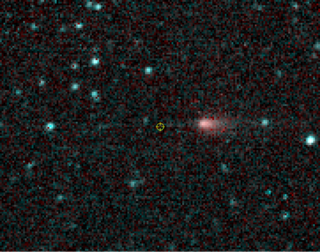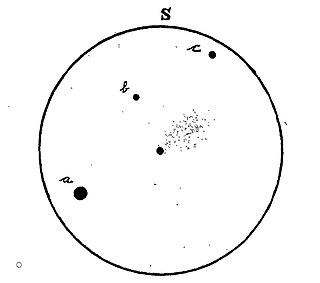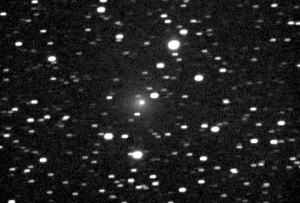Related Research Articles

57P/du Toit–Neujmin–Delporte is the designation of a periodic comet. It is a member of the Jupiter family of comets whose orbits and evolution are strongly influenced by the giant planet. In 2002 it was discovered to have broken up into at least 20 fragments. At the time of their discovery, these shed fragments were spread out along the orbital path subtending an angle of 27 arcminutes from the comet's surviving head.

28P/Neujmin, also known as Neujmin 1, is a large periodic comet in the Solar System. With a perihelion distance of 1.5AU, this comet does not make close approaches to the Earth.
42P/Neujmin, also known as Neujmin 3, is a periodic comet 2 km in diameter.

53P/Van Biesbroeck is a periodic comet 7 km in diameter. Its current orbital period is 12.53 years.

60P/Tsuchinshan, also known as Tsuchinshan 2, is a periodic comet in the Solar System with an orbital period of 6.79 years. Tsuchinshan is the Wade-Giles transliteration corresponding to the pinyin Zĭjīn Shān, which is Mandarin Chinese for "Purple Mountain".

77P/Longmore is a periodic comet in the Solar System, with a period of 6.8 years.

78P/Gehrels, also known as Gehrels 2, is a Jupiter-family periodic comet in the Solar System with a current orbital period of 7.22 years.

171P/Spahr is a periodic comet in the Solar System. 171P/Spahr was recovered on 20–24 October 2011 at apparent magnitude 20.6 using the 2.0-metre (79 in) Faulkes Telescope South. 171P/Spahr is peaked at about magnitude 18 in 2012.

7P/Pons–Winnecke is a periodic Jupiter-family comet with a six-year orbit. Early calculations for the 1921 apparition suggested that the orbit of the comet might collide with Earth in June, but observations on 10 April ruled out an impact. It made a very close approach to Earth in June 1927. The outward migration of perihelion created impressive meteor showers in 1916, 1921 and 1927.

11P/Tempel–Swift–LINEAR is a periodic Jupiter-family comet in the Solar System.

13P/Olbers is a periodic comet with an orbital period of 69 years. It fits the classical definition of a Halley-type comet with. The comet had last been seen in 1956 and the next perihelion is on 30 June 2024.
14P/Wolf is a periodic comet in the Solar System.

Comet Finlay is a periodic comet with an orbital period of 6 years discovered by William Henry Finlay on September 26, 1886. The next perihelion passage is July 13, 2021 when the comet will have a solar elongation of 54 degrees at approximately apparent magnitude 10. It last came to perihelion on December 27, 2014, at around magnitude 10. Of the numbered periodic comets, the orbit of 15P/Finlay has one of the smallest minimum orbit intersection distances with the orbit of Earth (E-MOID). In October 2060 the comet will pass about 5 million km from Earth.
18D/Perrine–Mrkos is a periodic comet in the Solar System, originally discovered by the American-Argentine astronomer Charles Dillon Perrine on December 9, 1896. For some time it was thought to be a fragment of Biela's Comet.
20D/Westphal was a periodic comet with an orbital period of 61 years. It fits the classical definition of a Halley-type comet. The comet appeared to disintergrate during the 1913 apparition and hasn't been observed since then.

23P/Brorsen–Metcalf is a periodic comet with an orbital period of 70 years. It fits the classical definition of a Halley-type comet with. It was first discovered by Theodor Brorsen at the Altona Observatory on July 20, 1847, and again by Kaspar Schweizer (Moscow) on August 11, 1847. It was predicted that it would reappear between 1919 and 1922.

Comet Schaumasse is a periodic comet discovered by Alexandre Schaumasse on 1 December 1911 as 12th magnitude. It next comes to perihelion on 8 January 2026 and should brighten to about magnitude 9.
Comet Taylor, is a periodic comet in the Solar System, first discovered by Clement J. Taylor on November 24, 1915.

62P/Tsuchinshan, also known as Tsuchinshan 1, is a periodic comet discovered on 1965 January 1 at Purple Mountain Observatory, Nanking. It will next come to perihelion on 25 December 2023 at around apparent magnitude 8, and will be 0.53 AU (79 million km) from Earth and 110 degrees from the Sun.
51P/Harrington is a periodic comet in the Solar System.
References
- 1 2 Seiichi Yoshida. "25D/Neujmin 2". Seiichi Yoshida's Comet Catalog. Retrieved 2019-02-26.
- 1 2 3 Kronk, Gary W. "25D/Neujmin 2" . Retrieved 2018-02-26. (Cometography Home Page)
- 1 2 "25D/Neujmin Orbit". Minor Planet Center . Retrieved 2019-02-26.

